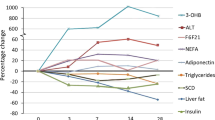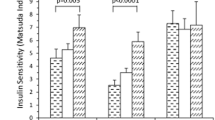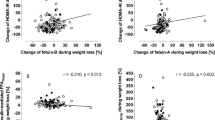Abstract
Background/Objectives:
We assessed the effect of weight loss-associated changes in detailed body composition on plasma insulin levels and homeostatic model assessment (HOMA) index to calculate the magnitude of reduction in different adipose tissue depots required to improve insulin sensitivity.
SubjectS/Methods:
A total of 50 subjects aged 20–69 years were studied. The participants were compiled from low-calorie diet interventions and bariatric surgery and differed in their baseline body mass index (BMI; range 21.6–54.4 kg/m2) and degree of weight losses (range −3.3 to −56.9 kg). Detailed body composition and liver fat were measured using whole-body magnetic resonance imaging (MRI). Insulin resistance was assessed by HOMA.
Results:
Mean body weight decreased by −16.0±13.6 kg. Significant changes were observed in total adipose tissue (TATMRI, range −0.5 to −36.0 kg), total subcutaneous adipose tissue (SATMRI), visceral adipose tissue (VATMRI), skeletal muscle, liver fat, plasma insulin levels and HOMA. Decreases in insulin and HOMA were correlated with reductions in TATMRI, SATMRI, VATMRI (just with HOMA) and liver fat. Losses of 2.9 and 6.5 kg body weight, 2.0 and 5.0 kg TATMRI as well as 1.6 and 6% liver fat were required to decrease plasma insulin levels by 1 μU/ml and HOMAadjusted for baseline HOMA by 1 point. Multiple regression analysis showed that baseline liver fat and changes in liver fat explained 49.7% and 55.1% of the variance in weight loss-associated changes in plasma insulin and HOMA, respectively.
Conclusions:
Decreases of adipose tissues and liver fat are the major determinants of reduction in plasma insulin levels and improvement in HOMA index.
This is a preview of subscription content, access via your institution
Access options
Subscribe to this journal
Receive 12 print issues and online access
$259.00 per year
only $21.58 per issue
Buy this article
- Purchase on Springer Link
- Instant access to full article PDF
Prices may be subject to local taxes which are calculated during checkout


Similar content being viewed by others
References
Douketis JD, Macie C, Thabane L, Williamson DF . Systematic review of long-term weight loss studies in obese adults: clinical significance and applicability to clinical practice. Int J Obes (2005) 2005; 29: 1153–1167.
Diabetes Prevention Program Research G Diabetes Prevention Program Research G, Knowler WC Diabetes Prevention Program Research G, Fowler SE Diabetes Prevention Program Research G, Hamman RF Diabetes Prevention Program Research G, Christophi CA Diabetes Prevention Program Research G, Hoffman HJ et al. 10-Year follow-up of diabetes incidence and weight loss in the Diabetes Prevention Program Outcomes Study. Lancet 2009; 374: 1677–1686.
Reaven G . All obese individuals are not created equal: insulin resistance is the major determinant of cardiovascular disease in overweight/obese individuals. Diabetes Vasc Dis Res 2005; 2: 105–112.
Stefan N, Haring HU . The metabolically benign and malignant fatty liver. Diabetes 2011; 60: 2011–2017.
Vega GL, Adams-Huet B, Peshock R, Willett D, Shah B, Grundy SM . Influence of body fat content and distribution on variation in metabolic risk. J Clin Endocrinol Metab 2006; 91: 4459–4466.
Despres JP, Lemieux I . Abdominal obesity and metabolic syndrome. Nature 2006; 444: 881–887.
Korenblat KM, Fabbrini E, Mohammed BS, Klein S . Liver, muscle, and adipose tissue insulin action is directly related to intrahepatic triglyceride content in obese subjects. Gastroenterology 2008; 134: 1369–1375.
Jakobsen MU, Berentzen T, Sorensen TI, Overvad K . Abdominal obesity and fatty liver. Epidemiol Rev 2007; 29: 77–87.
Fabbrini E, Magkos F, Mohammed BS, Pietka T, Abumrad NA, Patterson BW et al. Intrahepatic fat, not visceral fat, is linked with metabolic complications of obesity. Proc Natl Acad Sci USA 2009; 106: 15430–15435.
Hwang JH, Stein DT, Barzilai N, Cui MH, Tonelli J, Kishore P et al. Increased intrahepatic triglyceride is associated with peripheral insulin resistance: in vivo MR imaging and spectroscopy studies. Am J Physiol Endocrinol Metab 2007; 293: E1663–E1669.
Pourhassan M, Bosy-Westphal A, Schautz B, Braun W, Gluer CC, Muller MJ . Impact of body composition during weight change on resting energy expenditure and homeostasis model assessment index in overweight nonsmoking adults. Am J Clin Nutr 2014; 99: 779–791.
Bosy-Westphal A, Kossel E, Goele K, Blocker T, Lagerpusch M, Later W et al. Association of pericardial fat with liver fat and insulin sensitivity after diet-induced weight loss in overweight women. Obesity (Silver Spring, MD) 2010; 18: 2111–2117.
Wing RR, Lang W, Wadden TA, Safford M, Knowler WC, Bertoni AG et al. Benefits of modest weight loss in improving cardiovascular risk factors in overweight and obese individuals with type 2 diabetes. Diabetes Care 2011; 34: 1481–1486.
Wing RR, Jeffery RW . Effect of modest weight loss on changes in cardiovascular risk factors: are there differences between men and women or between weight loss and maintenance? Int J Obes Related Metab Disorders 1995; 19: 67–73.
Hamman RF, Wing RR, Edelstein SL, Lachin JM, Bray GA, Delahanty L et al. Effect of weight loss with lifestyle intervention on risk of diabetes. Diabetes Care 2006; 29: 2102–2107.
Erdmann J, Kallabis B, Oppel U, Sypchenko O, Wagenpfeil S, Schusdziarra V . Development of hyperinsulinemia and insulin resistance during the early stage of weight gain. Am J Physiol Endocrinol Metab 2008; 294: E568–E575.
Matthaei S, Stumvoll M, Kellerer M, Haring HU . Pathophysiology and pharmacological treatment of insulin resistance. Endocr Rev 2000; 21: 585–618.
Abdul-Ghani MA, Matsuda M, Balas B, DeFronzo RA . Muscle and liver insulin resistance indexes derived from the oral glucose tolerance test. Diabetes Care 2007; 30: 89–94.
DeFronzo RA, Tobin JD, Andres R . Glucose clamp technique: a method for quantifying insulin secretion and resistance. Am J Physiol 1979; 237: E214–E223.
Matthews DR, Hosker JP, Rudenski AS, Naylor BA, Treacher DF, Turner RC . Homeostasis model assessment: insulin resistance and beta-cell function from fasting plasma glucose and insulin concentrations in man. Diabetologia 1985; 28: 412–419.
Katz A, Nambi SS, Mather K, Baron AD, Follmann DA, Sullivan G et al. Quantitative insulin sensitivity check index: a simple, accurate method for assessing insulin sensitivity in humans. J Clin Endocrinol Metab 2000; 85: 2402–2410.
Lagerpusch M, Bosy-Westphal A, Kehden B, Peters A, Muller MJ . Effects of brief perturbations in energy balance on indices of glucose homeostasis in healthy lean men. Int J Obes (2005) 2012; 36: 1094–1101.
Lagerpusch M, Enderle J, Later W, Eggeling B, Pape D, Muller MJ et al. Impact of glycaemic index and dietary fibre on insulin sensitivity during the refeeding phase of a weight cycle in young healthy men. Br J Nutr 2013; 109: 1606–1616.
Bosy-Westphal A, Kossel E, Goele K, Later W, Hitze B, Settler U et al. Contribution of individual organ mass loss to weight loss-associated decline in resting energy expenditure. Am J Clin Nutr 2009; 90: 993–1001.
Bosy-Westphal A, Schautz B, Lagerpusch M, Pourhassan M, Braun W, Goele K et al. Effect of weight loss and regain on adipose tissue distribution, composition of lean mass and resting energy expenditure in young overweight and obese adults. Int J Obes (2005) 2013; 37: 1371–1377.
Stevens J, Truesdale KP, McClain JE, Cai J . The definition of weight maintenance. Int J Obes (2005) 2006; 30: 391–399.
Pourhassan M, Schautz B, Braun W, Gluer CC, Bosy-Westphal A, Muller MJ . Impact of body-composition methodology on the composition of weight loss and weight gain. Eur J Clin Nutr 2013; 67: 446–454.
Pourhassan M, Eggeling B, Schautz B, Johannsen M, Kiosz D, Gluer CC et al. Relationship between submaximal oxygen uptake, detailed body composition, and resting energy expenditure in overweight subjects. Am J Hum Biol 2014; 27: 397–406.
FA D . Physical Properties of Tissue. Academic: New York, NY, USA, 1990.
Snyder WS CM, Nasset ES, Karhausen LR, Howells GP, Tipton IH . Report of the Task Group on Reference Man. Pergamon Press: Oxford, UK, 1975.
Lagerpusch M, Enderle J, Eggeling B, Braun W, Johannsen M, Pape D et al. Carbohydrate quality and quantity affect glucose and lipid metabolism during weight regain in healthy men. J Nutr 2013; 143: 1593–1601.
Schneider CA, Rasband WS, Eliceiri KW . NIH Image to ImageJ: 25 years of image analysis. Nat Methods 2012; 9: 671–675.
Wing RR, Venditti E, Jakicic JM, Polley BA, Lang W . Lifestyle intervention in overweight individuals with a family history of diabetes. Diabetes Care 1998; 21: 350–359.
Su HY, Sheu WH, Chin HM, Jeng CY, Chen YD, Reaven GM . Effect of weight loss on blood pressure and insulin resistance in normotensive and hypertensive obese individuals. Am J Hypertension 1995; 8: 1067–1071.
Wing RR, Koeske R, Epstein LH, Nowalk MP, Gooding W, Becker D . Long-term effects of modest weight loss in type II diabetic patients. Arch Int Med 1987; 147: 1749–1753.
Kantartzis K, Machann J, Schick F, Fritsche A, Haring HU, Stefan N . The impact of liver fat vs visceral fat in determining categories of prediabetes. Diabetologia 2010; 53: 882–889.
Muller MJ, Lagerpusch M, Enderle J, Schautz B, Heller M, Bosy-Westphal A . Beyond the body mass index: tracking body composition in the pathogenesis of obesity and the metabolic syndrome. Obes Rev 2012; 13 (Suppl 2), 6–13.
Retnakaran R, Shen S, Hanley AJ, Vuksan V, Hamilton JK, Zinman B . Hyperbolic relationship between insulin secretion and sensitivity on oral glucose tolerance test. Obesity (Silver Spring, MD) 2008; 16: 1901–1907.
Kyle UG, Zhang FF, Morabia A, Pichard C . Longitudinal study of body composition changes associated with weight change and physical activity. Nutrition 2006; 22: 1103–1111.
Acknowledgements
We thank Britta Jux, Klinik fur Radiologische Diagnostik, University Hospital Schleswig Holstein Kiel, for help with MRI scanning. The study was funded by Deutsche Forschungsgemeinschaft (DFG Mü 714/ 8-3) BMBF Kompetenznetz Adipositas, Core domain 'Body composition' (Kö rperzusammensetzung; FKZ 01GI1125).
Author contributions
MP and MJM designed the study; MP did the segmentations and analyzed the data; C-CG was responsible for MRI examinations; PP and WT are surgeons and are responsible for recruitments and treatments of severely obese patients undergoing bariatric surgery; MP and MJM wrote the paper.
Author information
Authors and Affiliations
Corresponding author
Ethics declarations
Competing interests
The authors declare no conflict of interest.
Rights and permissions
About this article
Cite this article
Pourhassan, M., Glüer, CC., Pick, P. et al. Impact of weight loss-associated changes in detailed body composition as assessed by whole-body MRI on plasma insulin levels and homeostatis model assessment index. Eur J Clin Nutr 71, 212–218 (2017). https://doi.org/10.1038/ejcn.2016.189
Received:
Revised:
Accepted:
Published:
Issue Date:
DOI: https://doi.org/10.1038/ejcn.2016.189
This article is cited by
-
How Does Fat Mass Change in the First Year After Bariatric Surgery? A Systemic Review and Meta-Analysis
Obesity Surgery (2021)
-
Differential unfolded protein response in skeletal muscle from non-diabetic glucose tolerant or intolerant patients with obesity before and after bariatric surgery
Acta Diabetologica (2020)
-
Changes in Bile Acid Metabolism, Transport, and Signaling as Central Drivers for Metabolic Improvements After Bariatric Surgery
Current Obesity Reports (2019)
-
Weight Loss and Changes in Adipose Tissue and Skeletal Muscle Volume after Laparoscopic Sleeve Gastrectomy and Roux-en-Y Gastric Bypass: a Prospective Study with 12-Month Follow-Up
Obesity Surgery (2019)



